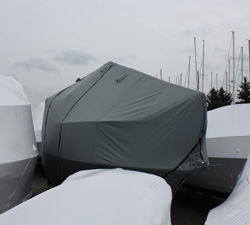Reusable Boat Covers

Investing in a reusable winter cover is a sound environmental choice and a practical way to facilitate winter maintenance on your boat.
Over the past few decades, more and more boats in Canada have been put away for the winter under shrink wrap. Properly applied, shrink wrap seals the boat from water and intrusion by creatures, its slippery surface sheds snow (when we get it), and it resists wind and sun all winter.
Shrink wrap can also be recycled quite effectively, and some shrink wrap suppliers have created programs to gather used wrap to ensure that it’s recycled and not disposed of in a landfill site.
Unfortunately, not every shrink wrap user is aware of this recycling opportunity. We saw a large quantity of it being stuffed into the back of a garbage truck at a yacht club this spring.
Before the advent of shrink wrap, we used to keep boats stored inside or under a canvas cover. Inside storage will always be best but it is hard to find and invariably expensive. That is why shrink wrap caught on so fast and has become so successful, although “shrink” isn’t the only new material to come along.
Recently, we’ve had a number of conversations with Nat Genco. The topic that caught our interest was the fact that he produces high-quality reusable winter boat covers that offer an alternative to shrink wrapping.
The material Genco uses is a coated polyester which is light, strong and very durable. It was first used as far back as the 1970s for covering snowmobiles, and it doesn’t rot the way traditional canvas eventually does.
For the environmentally conscious boater, these new, lightweight coated polyester covers typically enjoy a 10 to 12-year lifespan (some last up to 15 years) – and that alone represents a big reduction in environmental impact.
An equally important reason to choose a reusable cover is that it can facilitate access to the boat to do winter projects, whereas a shrink-wrapped boat is generally inaccessible until spring.
We think the smart boat owner plans ahead at this time of year, working with their marina or yard to determine what maintenance and upkeep needs to be done over the winter to ensure that the boat is going to perform to expectations all next summer. It makes sense to get the work done this winter when you are not using the boat. A reusable cover can really help facilitate that.
Some marinas can build a zipper into the shrink wrap on a larger boat, but a zipper can become a significant additional cost when shrink-wrapping a cottage-size boat. We rarely see wrappers with zipper access.
The reusable cover is also fastened differently. As Nat explained, “It’s an easy job to untie the cover, peel it back and replace it later. We generally supply loops every three feet and webbing or line to tie it tight. To keep it tight, we hang sand bags or water bottles, six pounds each. The tension keeps the cover from moving.”
He showed us a very clever wooden frame. Genco offers hardware to make the frame quickly and easily, using just a drill and saw.
The covers have vents that are sewn in, and you can specify custom features like points for lines to pass through, special shapes to go over superstructure and more. Doing this with shrink would require a lot of skill by the technician and obviously much more labour, given that shrink is a one-time-use product.
On covers for bigger boats, Genco fits seven vents and a door, but even smaller boat covers can have a door that is big enough for a man to bring in tools and work inside.
The framework can facilitate more air circulation to reduce the effects of condensation. There are solar-powered vents available to boost air circulation, too.
Nat pointed out that marinas using inexperienced help can safely use these covers. There’s no skill required to fit them, as there is in using tape and a torch to get the right tension on shrink wrap without burning the gelcoat.
So, while the reusable cover costs more initially, Nat claims that an owner will get a payback on the investment in just three years, and from then on, they are saving money as well as reducing their environmental footprint.
The advantage of winter access for service is a no-brainer. But consider also that easy winter access can facilitate showing the boat if you decide to sell or trade up.
Finally, a few brave souls actually leave their boat in the water under the reusable cover and live there! Sufficient air circulation can be engineered in, and the zippered access door can be robust enough to withstand regular use.
While we thank Genco Marine for sharing these ideas, there are many custom canvas shops and marinas which can create a cover for your boat. It may mean a little more effort and a little higher cost, but getting easy access to do winter projects and keeping some shrink out of a landfill site makes it seem both a practical choice and sound environmental practice.
By Andy Adams




























